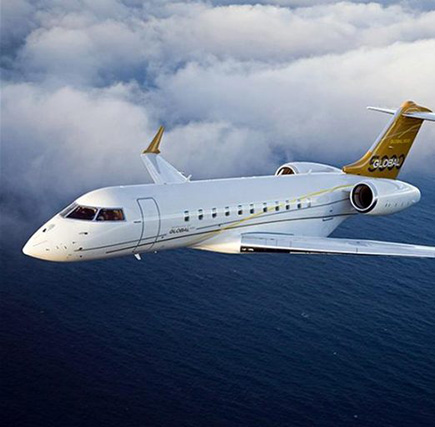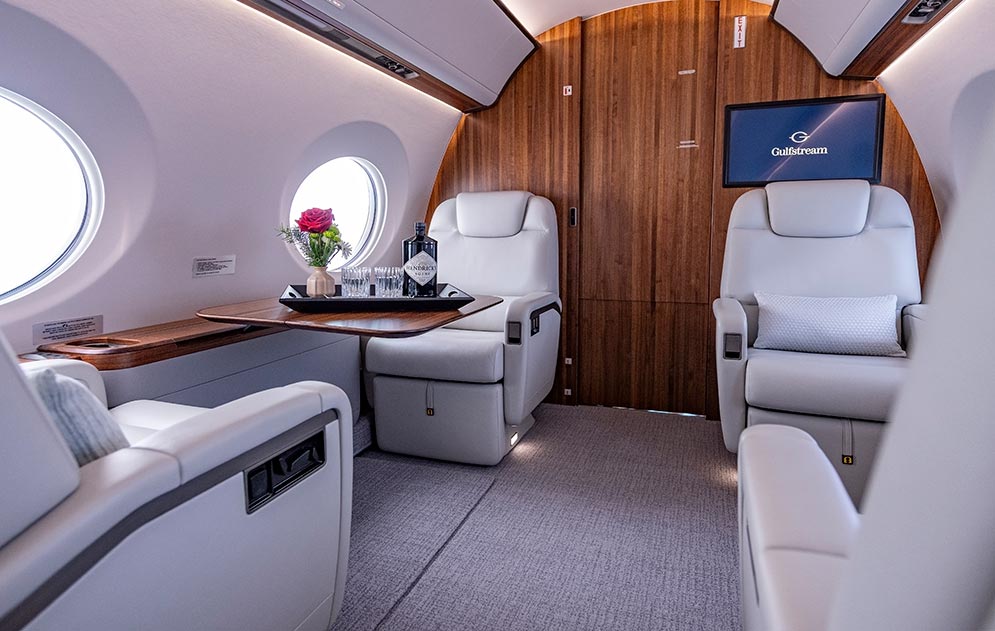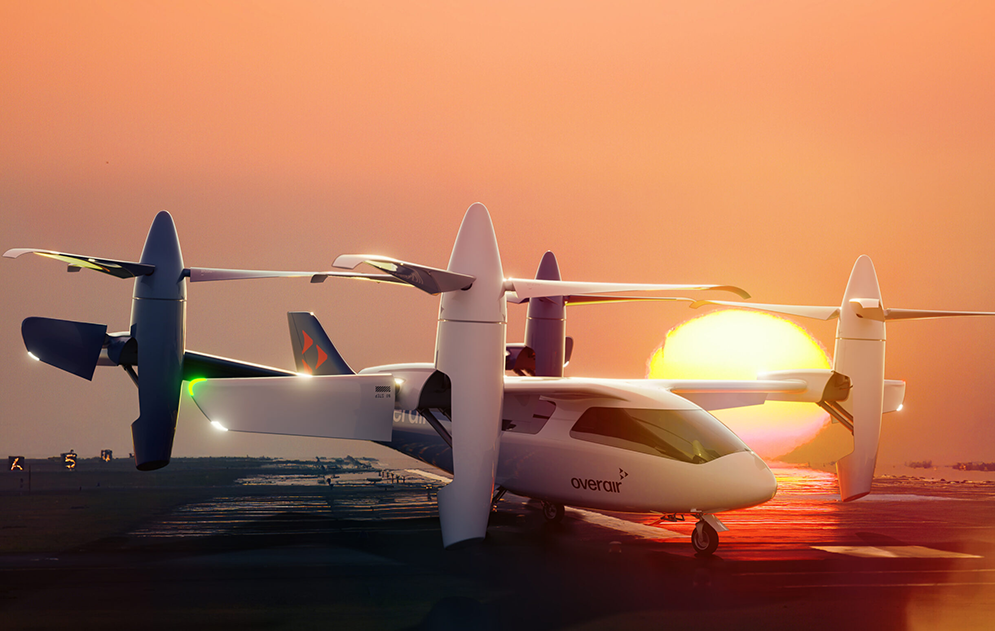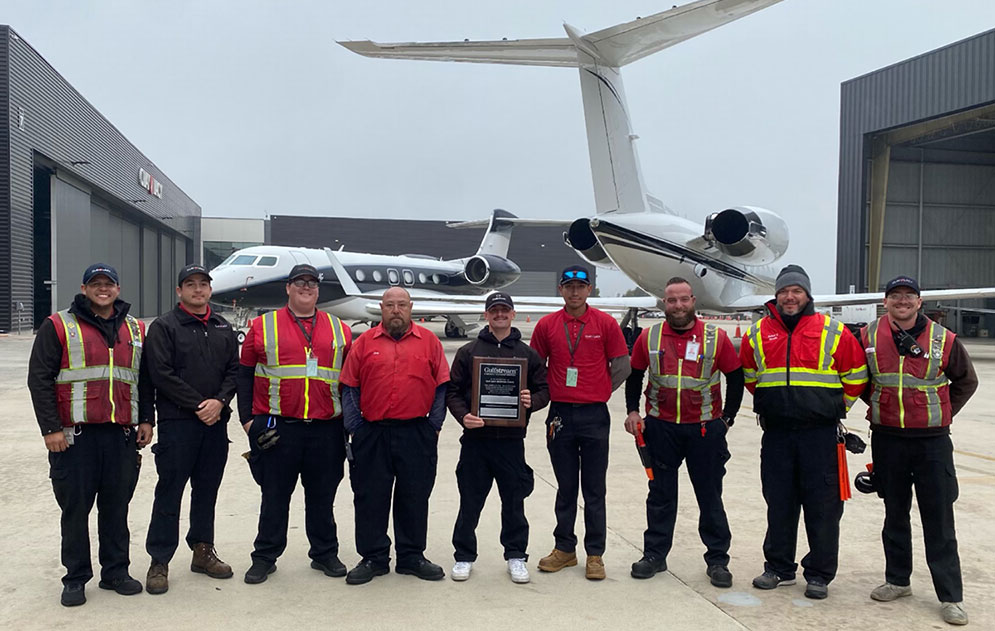
Bombardier Global 5000
By Clay Lacy in 2004 Professional Pilot Magazine “Flight Check”
ATP/CFII/Helo/Sea. Gulfstream II/III/IV,
Learjet and Citation Series
HS125, Boeing 747, DC3,
and 25 misc type ratings
BOMBARDIER GLOBAL 5000: $33.5 MIL, 8 SEATS, M.89, 4800 NM, FL510
Honeywell Primus 2000XP avionics suite, TCAS 2000, EGPWS, GPS, Rolls-Royce BR710A2-20 turbofans with 14750 lbs of thrust.
Introduced in Feb 2002 and FAA certified this October, Bombardier’s Global 5000 is one of the more interesting business aircraft to enter the marketplace in recent years. After removing 32 inches of fuselage, and 7600 lb of fuel, from the standard Global Express, the manufacturer has dropped the price about $10 million over its larger cousin to achieve a price point that competes head on with the Dassault Falcon 900EX and Gulfstream G450. The end result is the largest cabin in its class, 4800-nm range at Mach 0.85 and the same wing as the Global Express with its superb high and low speed characteristics.
The evolving super large business jet segment has become one of the hottest sectors of the market. For operators who fly predominantly transcontinental, or to Europe and South America, 4800 nm is all the range you need. And, when you can save millions over a Global Express, yet have the same wing, engines, thrust ratings and seated area, it has the potential to be a surefire winner.
As Bombardier has eliminated the 32-inch section from the galley and crew rest area, passengers won’t notice much cabin difference over the Global Express. In fact, this aircraft may be such a good deal that it will compete with pre-owned Global Expresses and the new $45.5- million Global Express XRS as well as its intended targets, the G450 and Falcon 900EX.
I had the opportunity to flight test the Global 5000 just after NBAA in Las Vegas NV. Bombardier Mgr Product Planning Global Family Marc Bouliane gave me a full briefing on the Global 5000 program and I had the pleasure of flying with Bombardier Demonstration Pilot Peter Boyd, a very capable pilot who’s been with the Global 5000 program since the beginning.
ROUNDTABLE DISCUSSION
The Global 5000 achieved Transport Canada certification on Mar 12, 2004, European Aviation Safety Agency (EASA) certification on Jul 15, JAA certification on Aug 24 and FAA FAR Part 25 certification on Sep 20. All 4 regulatory agencies awarded the Global 5000 a common type rating with the Global Express, so that no differences training, or additional simulator procedures, are required to transition between the 2 aircraft.
Bouliane explained that the Global 5000 was designed to fly nonstop from continental Europe to central North America at Mach 0.85 with 8 passengers and to fly transcontinental at Mach 0.89. Bombardier is particularly proud of the 3-zone Global 5000 cabin—42 ft 6 in by 8 ft 2 in—and of the fact that it’s engineered to be among the most effective offices in the sky.
The 5000 incorporates the first Ethernet-based Rockwell Collins Airshow 21 application in corporate aviation. It will also, apparently, be the first purpose-built corporate aircraft capable of data transfer speeds up to 5 MB per second. Standard equipment includes a local area network (LAN) and multichannel satellite communication inter- faces with Inmarsat Aero H+ and Swift64 communications, as well as Iridium service. Adding to cabin comfort, the Global 5000 comes complete with forward and aft Envirovac vacuum lavs, Goodrich-Hella LED cabin lighting, new waste and water management systems and new design seating.
While the Global Express and the 5000 share the same wing and same 14,750-lb-thrust Rolls- Royce Deutschland BR710s, MTOW has been reduced by 8300 lb from 96,000 lb to 87,700 lb. Fuel capacity has been reduced by 7600 lb.
Range has been reduced by 1350 nm from that of the Global Express XRS. Bouliane explained that fuel capacity and MTOW were ratcheted down in the interests of product differentiation and in order to achieve 4800 nm at Mach 0.85 with 8 passengers.
Other things being equal, cabin space is what corporate jet owners are looking for and they’ll certainly get it with the Global 5000. Compared to the G450, the 5000’s seated area is 20 inches larger. It’s also wider by 10 in at centerline and by 17 in at floorline. In contrast with the Falcon 900EX, the 5000’s seated area is 48 inches larger, 6 in wider at centerline and more than 8 in wider at floorline.
Bombardier won’t reveal sales figures on the Global 5000, but they’ve delivered more than 140 Global Expresses and it’s my feeling that the 5000 may do even better.
It’s quite a deal— you save yourself $10 million by sacrificing some range and customizable cabin area. I can see how, in the future, someone might come up with an STC to increase MTOW and add back the fuel, and thus the range, of the 5000, as it has the same engine thrust as the Global Express and similar basic operating weight.
PREFLIGHT
Boyd and I headed out to the ramp at HND (Henderson Exec, Las Vegas NV) for walkaround and preflight. The 94-ft-span wing, with its 35° sweep and full span leading edge devices, is a great piece of engineering, effective for both slow and high speed flight.
A nice feature on the 5000 is the preselect fuel panel. You just hook up, dial in the fuel quantity you want and it shuts itself off. Boyd pointed out the ram air turbine (RAT) port on the right side—a similar arrangement to that on the Challenger 604 and the Global Express. Baggage capacity is a generous 185 cu ft and it’s both externally and internally accessible. I found the entry stairs rather steep, at an angle something greater than 45°, but this is the same as the Global Express.
Turning right at the top of the airstairs, I spent some time getting a feel for the cabin. While our flight test aircraft still had some test equipment in the back, cabin spaciousness, fit and finish seemed ideal for missions of up to 10 hours. You lose the Global Express’s crew rest area with the Global 5000 but I see no reason why an operator couldn’t put this back in with a trade-off of 32 inches of passenger cabin area.
The 5000’s flightdeck is physically identical to the Global Express and I would say it’s the nicest flightdeck of any airplane I’ve ever been in. There’s lots of room, everything is simple, well laid out and designed for reduced pilot workload.
Our flight test aircraft had a Honeywell Primus 2000XP panel with Thales head-up flight display system (HFDS), triple FMS, dual HF, 3 VHFs, dual radio management units, ARINC with datalink and 3 independent audio panels for captain, first officer and observer.
I like the nice big flight spoiler handle on the left side of the throttle, the easy-to-set parking brake and the adjustability of the pilot seats. The ‘dark panel’ concept EICAS is very effective and you can call up whatever system synoptics you want to look at on EICAS. Other nice features of the 5000 include an electronic chart touchscreen, on the copilot side, and the electrical management system central display unit, which can also control the cabin systems and circuit breakers. While our flight test aircraft did not have enhanced vision (EVS), Transport Canada certification of a Bombardier EVS (BEVS) for the Global family is anticipated in March or April 2005. It will be an option on the 5000.
The Thales HFDS hangs quite low over your head. It doesn’t get in the way when you’re seated, but I had to lean to the right a little to exit the seat. The only thing I don’t like about the Global 5000 flightdeck is its rather small windscreen—but this is never going to change, so you just get used to it. And it does allow the pilot to see the wingtip while taxiing.
Engine start was easy. Everything happens automatically—you just move one switch to engage the starter and it takes care of everything. APU is also a single-switch operation.
Pilot workload is very low on the Global 5000. On taxi-out I noted how smooth and effective the brake and steer-by-wire systems were. Turning radius is good, with up to ±7.5° turning authority using the pedals and up to 75° with nose wheel steering.
For our flight today, takeoff weight was 70,909 lb (81% of MTOW) with 18,650 lb of fuel and 4 passengers/technicians in the back. Boyd and I taxied out to Runway 19 at HND with an IFR flightplan filed to MMM VOR, about 70 nm NE of Las Vegas and then to LAS (McCarran, Las Vegas NV). BFL was 4200 ft with ISA+20 conditions. V1 and Vr were 108 kts, with V2 at 121 kts.
FLYING THE GLOBAL 5000
Departing Rwy 19, I flew a low pass for photo purposes and noted the easy low-speed handling characteristics of this airplane. Using the book rate of 250 kts, we climbed to 13,000 ft for handling exercises. I flew maneuvers in all configurations with 30° and 45° banks— clean, 6° flaps/slats out, 16° flaps/slats out and 30° flaps/slats out with gear down. Handling speeds for those configurations were 200, 160, 140 and 130 kts, respectively, and the 5000 felt solid and stable in all maneuvers.
While we didn’t go to full stall, stick shaker came on at 92 kts with gear down and flaps 30 at our weight of 69,500 lb. I was impressed with the slow speed handling characteristics of this airplane. At slow speeds of 110 kts, the Global 5000 handles great. Its controls are well harmonized in pitch and roll, and rudder control felt just right.
Next, Boyd and I climbed to FL410, where I accelerated to Mach 0.85 to verify cruise speed and fuel flow. At our weight we were burning 1570 lb per side at cruise—right on the book figures. Taking into account our low-level fly-by and a couple of short level-offs, our adjusted climb time to FL410 was 18 minutes.
At FL410 I turned off the autopilot again to do 45° bank turns. In roll, when you move the wheel more than about 20°, flight spoilers come up to provide roll assist. The Global 5000 has 4 ground spoilers as well as multifunction spoilers—all spoilers actuate as ground spoilers on landing. In the event of aileron lock, Boyd showed me how roll is controlled with spoilers.
Entering a modified emergency descent, on autopilot with spoilers out and approaching Mmo, we descended nicely to FL240 at better than 10,000 fpm. We were cleared on a visual approach to Runway 19R at LAS. Vref at our landing weight of 67,000 lb was 119 kts.
Due to traffic at the field, we were able to do just one landing. Using light brake pressure and normal reverse, ground roll was 2500 ft. Vref speeds are nice and low on the Global 5000 and I found its landing characteristics excellent. With its big trailing link main gear, the Global 5000 will make any pilot look good to his or her passengers.
My objective on this 1 hr 50 min flight was to fly a more-or-less typical corporate mission profile with the addition of some slow speed work. I used the Thales HFDS throughout the flight and found it both user- friendly and intuitive. In my view, when Bombardier’s EVS system, with its forward-looking infrared sensor, is certified and available for the Global family in March or April, it’s going to be a really great addition.
SYSTEMS
As I mentioned previously, the flightdeck of the Global 5000 is truly superb. The 6-display Honeywell Primus 2000XP panel incorporates many functions that go beyond what has typically been associated with avionics. This is backed up with the HFDS and a wonderful EICAS to help the flightcrew make good decisions quickly.
Rolls-Royce BR710s come with 2-channel FADEC and are designed for on-condition type maintenance—checks are based on MSG3 processes. The Honeywell RE220 APU also comes with FADEC and is easily accessed for servicing via 2 clamshell cowl doors.
Electrical power is provided by 4 engine-driven generators (40 kVA each), an APU-driven generator (40 kVA) and the RAT (9 kVA). DC power, required for most avionics and some cabin systems, is provided by 4 28-volt DC transformer rectifier units (TRUs). The RAT extends automatically, within 6 seconds, in the absence of AC sources or in the event of dual engine failure.
Three fully independent hydraulic systems, featuring 2 engine-driven pumps, 4 electric hydraulic pumps and a RAT, supply hydraulic power to the ailerons, elevators, rudder, brakes, spoilers, steering and thrust reversers. Flight controls are hydraulically powered with 5 separate power control unit (PCU) servo actuators. The Global 5000’s 8 multifunction flight spoilers and 4 ground spoilers are hydraulically powered, while the 6 segment trailing-edge Fowler flaps and 8 segments of leading edge slats are electrically powered. Stall protection is provided with stick shaker and stick pusher.
The 5000 carries 36,000 lb of fuel in a wet-wing box structure with left, center fuselage and right tanks and fuel delivered to each engine via 4 AC boost pumps. Environmental controls offer either 100% outside air or recirculation of up to 40% of cabin air. The supply of conditioned fresh air to the cabin and flightdeck is fed by separate systems. A 9.6-psi cabin pressurization system provides a 6000-ft cabin up to FL450 and a 7230-ft cabin at FL510. Wing and engine anti-ice protection is by engine bleed air, while windshields and probes are anti-iced electrically. No tail anti-icing is required.
Tricycle-type landing gear features hydraulically-powered and electrically actuated carbon brakes with anti-skid and automatic braking capability. The steering system comprises electronically controlled, hydraulically powered steering actuation of the nose landing gear for taxi, takeoff and landing. Steering commands are input through the pilot’s hand wheel (full authority) or rudder pedals (limited authority).
Bouliane explained to me that every Global 5000 will be delivered “very complete”—right down to the provisioning of 18 coat hangars, 4 golf-size umbrellas and 8 sets of keys to the aircraft.
Bombardier has always had good product support, particularly on its larger aircraft. Global 5000 owners will have access to 7 factory service centers and 15 authorized service centers. Bouliane noted most service centers have on-site engineering support and 24/7 AOG service.
SUMMARY
I was impressed by the Global 5000’s handling qualities and flightdeck layout—and by its well-conceived levels of automation. But the individual or the company looking to buy a super-large-category business jet is going to be more interested in cabin spaciousness and functionality. They won’t be disappointed in this regard, either. The Global 5000 seems to me to be a great deal. It also offers the most performance, range and cabin in its class.
This is a fast airplane and it’s nimble enough to get you in and out of 4000-ft runways. But keep in mind that the Global 5000 is a big airplane with a 94-ft wingspan. There are going to be some fields that have enough runway to land on but that won’t have the taxi and ramp infrastructure, or available parking, for you. These days, business aircraft manufacturers are all trying hard to ‘ladder’ their products and fill in gaps in their product lines. Bombardier shrunk the Global Express to come up with the Global 5000, as it was a less expensive and faster option than designing and certifying an all-new airplane—buyers are going to be the winners here. If you’d like to have a Global Express sized passenger seated area, and you don’t mind stepping down to 4800-nm range for a savings of $10 million or so, the Global 5000 is an airplane you really need to evaluate.

Clay Lacy, founder of Clay Lacy Aviation at VNY (Van Nuys CA), is a highly experienced pilot who has been performing flightchecks and writing other articles for Professional Pilot since May 1997.


